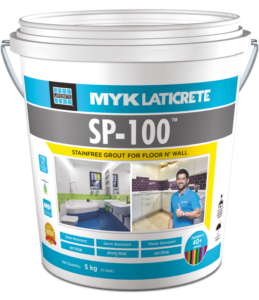FAQs

LATICRETE® 600
Frequently Asked Questions
LATICRETE® 600 Series is cement based joint filling material for tile / stone joints, used in internal & external floor and wall areas. This grout is designed to be used with LATICRETE® 1776 grout admix plus liquid.
It is called LATICRETE® 600 Series grout as it is has many colors available as variants to choose from and the first digit starts with 6 and ends with the number code of the color. For example, LATICRETE® 645 stands for Raven color and LATICRETE® 644 stands for bright white color. All the color variants have the same physical properties when used and don’t differ in performance. It is called un-sanded as it is used to fill narrow joints up to 3mm width.
There are two pack sizes available: 0.5 Kg, 1 Kg and 10 Kg.
You can use LATICRETE® 600 Series grout mixed with LATICRETE® 1776 grout admix plus, for internal and external areas like residential, commercial, Industrial floors and walls to install in the joints of ceramic / vitrified/ glass mosaic tiles and engineered marble/quartz stones, natural stones etc.
400 ml of L 1776 grout admix plus liquid should be mixed with 1 kg of this product. It is recommended to use LATICRETE® 1776 grout admix plus instead of water to give better stain resistance, flexibility and durable performance.
The following preparation must be done before application of LATICRETE® 600 Series grout:
- Clean the surface of the tiles and joints free of dust and debris with wet cloth or sponge. Remove spacers from the joints.
- Find out if the tiles were washed with acid based cleaners. If washed with acid based cleaners, wash the tiles again with plenty of clean water to remove any acidic remains in the joints.
- Don’t allow water to stand in the grout joints prior to grouting. Allow the joints to become dry.
- Check if all the tools and sufficient grout material is available for completion of job without any disturbance.
- Cordon off the area and don’t allow any traffic after cleaning the joints.
The following precautions are very important and critical while application of LATICRETE® 600 Series grout:
- Don’t mix with dirty water. Always use clean potable water for to mix with the powder if L1776 admix is not used.
- Do not mix the grout in dirty pails, buckets. Always use clean pail to get the best results.
- If the temperature is too low (Below 12 Degrees Centigrade), use heaters to increase the temperature while installing grout. If the temperature is too high (more than 35 Degrees Centigrade), use cold water or work during the evening / night / early morning to get best results.
- Don’t use putty blades for application of grout: Putty blades are metallic blades which will leave scratches on the tile surface. ALWAYS USE RUBBER FLOATS so that the tile doesn’t get scratched.
- Don’t allow any other works like plumbing, electrical fittings, plastering, tiling or painting to be done in the grouting area while applying the grout. If there is dust in the air, it settles down on the grouted joint which will be difficult to remove. Don’t allow any traffic other than people who are working with grout.
- Start initial cleaning with a white sponge in about 30 – 45 minutes time from the time of filling up of joints. Final cleaning must be carried out after 24 hours from the time of first cleaning.
- Always use potable quality clean water for first and final cleaning of the grout joints.
Foot traffic is allowed after 24 hours from the final cleaning of the grout. Heavy traffic is allowed only after 7 days from the day of final cleaning of grout joints.
The minimum width of joint should be 1mm and maximum size (width) of joint should be 3mm for installation with LATICRETE® 600 series grout. If you are installing grout in joints wider than 3mm, use LATICRETE® 500 series sanded grout mixed with LATICRETE® 1776 grout admix plus.
The advantage is it is stain resistant, flexible and easy to apply besides being very economical. Besides this, it does not crack, powder or disintegrate with time. It can be safely used on external facades, un-covered terraces, interior walls and floors.

